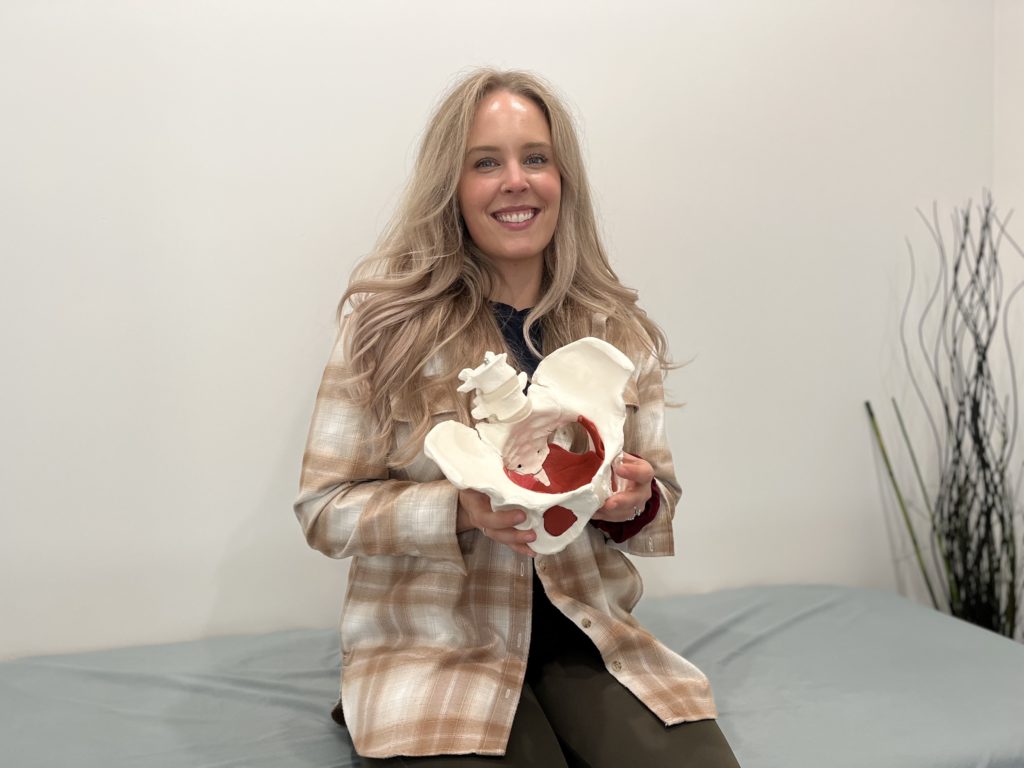Say it Loud!
Pelvic Health Deserves our Attention
We’re here to slay the stigma.
Despite how far we’ve come in understanding our bodies and minds better, women’s health is still often shrouded in secrecy and sensitivity. So much so, that many women are unaware of the pelvic physiotherapy treatments available to them—and suffer in silence.
Optimize Physiotherapy is here to change that, and our very own Courtney is leading that charge. Armed with a strong passion for helping women and their pelvic health, she’s here to knock down walls, change the narrative, and empower women to take back control of their bodies!
Let’s Talk Openly
Ever experienced urine leakage with exercise or laughter, painful
intercourse, or urinary frequency and/or urgency? Whether it’s a minor annoyance or a serious source of pain, you’re certainly not alone. Every one of these challenges deserve discussion and action—and is why we’re so passionate about pelvic rehabilitation.
Although women’s postpartum recovery is a big part of Courtney’s specialization, it’s certainly not only who she treats. “There are several other factors that can affect pelvic floor function in women of all ages, regardless if they have been pregnant or not,” she explains.

What Conditions Respond Well to Pelvic Floor Rehabilitation?
• Pelvic pain
• Diastasis recti
• Birth Preparation
• Pelvic Organ Prolapse
• Postpartum recovery
• Urgency and frequency of urination
• Stress incontinence (urine leakage with laughing, coughing, or exercise)
What is Pelvic Health Physiotherapy?
As a pelvic health physiotherapist, Courtney is specially trained to rehabilitate the pelvic floor muscles. They help to increase mobility
and strength and reduce pain with manual techniques, gentle stretches, and exercise. Before any of that happens though, she performs an assessment of the muscles, joints, and connective
tissues of the pelvis, low back, and hips. From there, direction and treatment is 100% tailored to fit you, your body, and your life.
“Pelvic floor and core activation can be hard,” says Courtney. “But I’m here to make sure you’re gentle with yourself; you’re just learning! I’ll guide you at your own pace.” Patience, knowledge, and wholehearted support—that’s exactly what Courtney has loads of.
The Pregnancy Factor
While pelvis rehabilitation is for nearly any woman, pregnancy and postpartum tend to be when bothersome pelvic problems arise. “This is a difficult time considering the changes the body experiences,” says Courtney. “Just remember, your body is literally making and delivering a tiny human! YOU ARE AMAZING!”
Wondering how long to wait after giving birth to see a pelvic floor physiotherapist? Optimize recommends it following your six-week
check up. Ensure your OB/GYN has cleared you to start physiotherapy, and then we’re good to get started!
But I’m Fine, I do Kegels!
We’re dropping the bomb: kegels are not always the best exercise for pelvic floor problems. A lot of times women assume their leaks are thanks to weakened pelvic floor muscles. The truth? A large portion of women’s leakage or urinary urgency is caused by overactive pelvic floor muscles—they just don’t ever fully relax.
Another kegel conundrum is that many women perform the contraction incorrectly. A proper “kegel” is an isolated contraction of the pelvic floor muscles, but most women do too much and contract their abs, glutes, and inner thigh muscles instead. This then increases intra-abdominal pressure.
Imagine this scenario: a woman feels a sneeze coming and tries to kegel in an attempt to avoid leakage. She’s actually increasing the pressure on her bladder—making her likelihood of leaking higher! That’s why it’s so essential that we teach proper contraction and full relaxation to train these muscles properly. It’s a key component of Courtney’s rehabilitation.

Wherever you are in your quest for better pelvic health, we are here to help you feel empowered in your body and enjoy the life you love. Come in to see Courtney and start reaching your personal pelvic goals. As a woman, you deserve it.